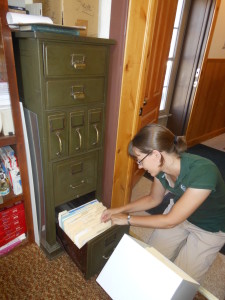Irrigation ditches lace the lands of Colorado, transporting water required for raising crops and tying mountains to plains, rural areas to urban. The Water Resources Archive at the Colorado State University Libraries preserves the history of these fundamental features of the state’s heritage and landscape and is celebrating the receipt of its 100th collection of significant documents.

The North Poudre Irrigation Company (NPIC), one of the largest irrigation companies in northern Colorado, has donated its historical records to the Water Resources Archive. Among NPIC’s 73 boxes, 10 ledgers, and approximately 1,000 large maps, plans and aerial photos reside details of the company’s 1901 origins and its development of nearly two dozen storage reservoirs and 200 miles of ditches.
“This is now the largest archival collection documenting an irrigation company in the state,” said archivist Patty Rettig. The next largest, also at the Water Resources Archive, is from the opposite corner of Colorado and documents the Montezuma Valley Irrigation Company.
After Archives staff clean the materials of dust and mold, organize and inventory them, the collection will be accessible to the public.
“We appreciate the Archive’s professionalism and help with this process and project.” said Scott Hummer, NPIC general manager, who facilitated the donation.
Other collections available
The Archive’s 99th collection, the Papers of Loretta Lohman, is the first collection in the repository to document the work of a woman in water. Dr. Lohman’s lifetime of research on Western water issues focused on the economic effects of water reuse, salinity, federal reclamation projects, and energy use.
Other collections in the Water Resources Archive include the Papers of Delph E. Carpenter and Family, the Ralph L. Parshall Collection, and the Records of Wright Water Engineers, respectively documenting the development of interstate river compacts, flumes and early irrigation practices, and investigations of water rights related to engineering projects.
“By rescuing historical documents from inadequate, inaccessible storage, we can provide access to a virtual time machine to see how our society developed,” said Rettig,
The Water Resources Archive, which opened in 2001 to collect, preserve, and promote the unique documents that capture Colorado’s water history, has grown substantially over the last 14 years. Its collections are now so extensive they would extend over a half mile if all the boxes were placed end to end.
The Archive broadly collects documentation of water across the state of Colorado, and even beyond. Collections have come from as far away as California and Nebraska. Donors benefit from having collections inventoried and potentially digitized. The public benefits from accessibility for general use, such as scholastic studies, legal cases, filmmaking, or family genealogy.
The collections are accessible in Suite 202 of Morgan Library on the CSU campus in Fort Collins from 8:30-4:30, Monday through Friday. Also, about 5 percent of the total holdings are digitally available online.
For more information, visit the Archive’s website or call 970-491-1844.